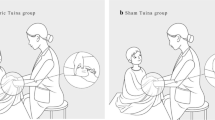Abstract
Objective
To observe the clinical efficacy of Shanghai-style tuina method based on syndrome differentiation in treating infantile diarrhea.
Methods
Sixty patients were randomly divided into an observation group and a control group, 30 cases in each group. The patients in the observation group were treated by Shanghai-style tuina method based on syndrome differentiation, while the patients in the control group were treated by conventional Shanghai-style tuina method, once per day, continuous 5 d for a treatment course. The efficacy was evaluated according to the score of the quantization table for symptoms differentiation in infantile diarrhea after one course.
Results
During the treatment, two cases in the control group dropped out. After treatment, the scores were significantly decreased in both groups and the intra-group differences were statistically significant (both P<0.01), indicating the two treatment methods were effective with infantile diarrhea. In the efficacies of traditional Chinese medicine (TCM) syndrome, the cured and markedly effective rate in the observation group was significantly higher than that in the control group (P<0.05), suggesting that Shanghai-style tuina method based on syndrome differentiation was more effective than conventional Shanghai-style tuina method.
Conclusion
Conventional Shanghai-style tuina method is characterized by fixed acupoints, remembering easily and operating conveniently. It has a significant effect in treating children with diarrhea, and is worthy of clinical promotion and popularization. However, Shanghai-style tuina method based on syndromes differentiation requires the solid theoretical foundation and rich clinical experience of TCM. And because Shanghai-style tuina method based on syndromes differentiation is applied under the guidance of syndrome differentiation and TCM theory, it can improve the clinical efficacy.
摘要
目的
观察海派推拿法辨证分型治疗小儿腹泻的临床疗效。
方法
将符合诊断标准的60 例受试者随机分为观察组和对照组, 每组30 例, 观察组采用海派推拿辨证分型方治疗, 对照组采用海派推拿基础方治疗。每天治疗1 次, 连续治疗5 d 为1 个疗程, 治疗1 个疗程后根据小儿泄泻病症状分型量化表评分评价疗效。
结果
治疗过程中, 对照组脱落2 例。治疗后, 两组症状评分均明显下降, 与本组治疗前有统计学差异(均P<0.01), 说 明两种治疗方案对小儿腹泻均有效。两组中医证候疗效比较, 观察组愈显率明显高于对照组(P<0.05), 说明海派 推拿辨证分型治疗小儿腹泻临床疗效优于海派推拿基础方治疗。
结论
海派推拿基础方具有手法取穴固定、方便记忆与操作的特点, 在治疗小儿腹泻方面具有显著疗效, 值得临床推广与普及。海派推拿辨证分型方则需要扎实的中医理论基础和丰富的临床经验, 在中医辨证论治理论指导下应用推拿手法, 能提高临床疗效。
Similar content being viewed by others
References
Fang HY, Fang HS. Progress of infantile diarrhea’s diagnosis and treatment. Xiandai Shiyong Yixue, 2003, 15(10): 607–610.
Wang YQ, Shi SP, Liang H. Diagnostic and Therapeutic Guidelines for Pediatric Diseases. Beijing: Press of Military Medical Sciences, 2008: 196.
Jin YC. The formation of pediatric tuina. Collection of State Academic Salon and Congress of Chinese Medicine Pediatric Tuina, 2009.
Jin YC. Shanghai-style Pediatric Tuina. Shanghai: Shanghai Scientific and Technical Publishers, 2010.
Chen ZW, Shen YJ, Wang Q. Summary of professor Jin Yi-cheng’s academic thoughts on pediatric tuina therapy. J Acupunct Tuina Sci, 2015, 13(2): 83–92.
Ministry of Health of the People’s Republic of China. China diagnosis and treatment scheme of diarrhea. Zhongguo Shiyong Erke Zazhi, 1998, 13(6): 381–384.
Chen YH. Criteria of Pediatric Diseases Diagnosis and Therapeutic Effect. Shanghai: Publishing House of Shanghai University of Traditional Chinese Medicine, 2006.
Zhao RM. Clinical research of tuina treating infantile diarrhea. Zhongguo Yiyao Zhinan, 2013, 11(25): 509.
Jin YC, Peng J. Chinese Tuina. Changsha: Hunan Science and Technology Press, 1992.
Author information
Authors and Affiliations
Corresponding author
Rights and permissions
About this article
Cite this article
Shen, Yj., Chen, Zw. Therapeutic effect observation of Shanghai-style tuina method for infantile diarrhea. J. Acupunct. Tuina. Sci. 14, 347–352 (2016). https://doi.org/10.1007/s11726-016-0947-x
Received:
Accepted:
Published:
Issue Date:
DOI: https://doi.org/10.1007/s11726-016-0947-x




